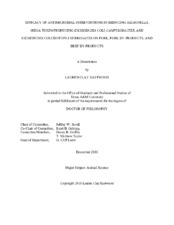| dc.description.abstract | Information regarding the effectiveness of antimicrobial interventions on pork carcasses, pork by-products, and beef by-products is limited. To determine the efficacy of various antimicrobial interventions on pork carcasses, hogs were harvested (n = 12) at the Texas A&M University Rosenthal Meat Science and Technology Center (College Station, TX), and skin-on and skinless pieces were designated as hot or chilled for antimicrobial application. Beef and pork head meat, cheek meat, hearts, and pork livers were collected from carcasses harvested at Texas A&M (College Station) and two commercial processing facilities. Warm pieces of all product types were transported to the Texas A&M Food Microbiology Lab where they were inoculated with Salmonella, STEC, Campylobacter or Escherichia coli biotype I surrogates. Following a 30 min microbial attachment period, inoculated pieces were assigned to one of six antimicrobial treatments: 2.5% room temperature lactic acid, 2.5% hot (55 °C) lactic acid, 5.0% room temperature lactic acid, 5.0% hot (55 °C) lactic acid, 400 ppm peroxyacetic acid, and hot (55 °C) water. For each inoculum type, samples were taken before applying the antimicrobial treatment to the warm pork and beef tissue, 30 min, and 24 h post-treatment. For chilled pork, samples were taken after 24 h chill and 30 min after treatment. Objective and trained panel color evaluations were performed on hot and chilled skinless pork, pork head meat, cheek meat, hearts, and livers to assess color attributes before and after antimicrobial application. Lactic acid at both concentrations and temperatures and peroxyacetic acid generally reduced (P < 0.05) counts of Salmonella, STEC, E. coli biotype I surrogates, and Campylobacter, whereas hot water did not have a similar impact. Further, greater reductions were seen across all treatments on beef and pork hearts and pork livers. There were minimal negative impacts on product color, primarily as a result of lactic acid compared to peroxyacetic acid and hot water treatments. This study provides valuable information for beef and pork establishments to help support their food safety programs. Validation of commonly used antimicrobial interventions specific to these products will help the industry comply with regulatory requirements and trade expectations. | en |


